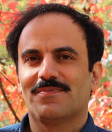Interview with Seyedmahdi (Mehdi) Moghadasi
Written by Mehdi Moghadasi
An Interview with Seyedmahdi (Mehdi) Moghadasi, senior technology architect for Open Access Technology International Inc.'s Smart Grid department.
1. What is your name, what have you studied and where have you worked in the past 3 years?
My name is Seyedmahdi (Mehdi) Moghadasi. I received my PhD in electrical engineering from The University of North Carolina at Charlotte. I joined Open Access Technology International Inc. (OATI) in 2017, where I have been working as a senior technology architect with the Smart Grid department for the past 4 years.
2. How did you get involved with the Smart Grid as a field of the power systems research and/or industry? How would you define the Smart Grid and what are your thoughts and aspirations on what the Smart Grid will be shaped to be in the next 10 years?
Integrating novel energy resources, and various flow and voltage controllers into the power system are very fascinating to me. The high penetration of distributed energy resources (DERs) increases the degree of freedom in power system operation and control. However, this transition brings very challenging problems regarding market participation, scheduling, operation, control, reliability, and planning of distribution systems. I have been studying and working in this area since 2003. During my PhD, I applied efficient optimization and control methods for solving dynamic optimal power flow problem in distribution system incorporating DERs.
Emerging technologies, DERs, and the customer demands have stretched the grid to its capacity and made it impossible to continue handling the buildup of new devices equipped with advanced computational and communication capabilities by just patching the conventional grid. The Smart Grid and grid modernization initiatives are the way forward to holistically address the challenges regarding energy efficiency, resiliency, reliability, operation, and security of power system with increased penetration of DERs.
Smart Grid concepts and implementations are moving forward, despite some changes in policies and priorities. The energy consumers, the private sector and public entities are becoming the primary driving force in the technology advancement and its deployment to shape a more efficient, adaptive, clean, and secure grid. The policies, regulations (e.g. FERC orders), and standards will obviously play an important role in the development pace and direction of the grid of the future.
3. What have been the 2 articles that you have liked from the IEEE SG eNewsletter in the past 3 years?
I have read many great articles in the IEEE SG eNewsletter in the past 3 years and I feel I would not make justice by picking just 2 of them. I will say though that I am most interested in articles focusing on the grid optimization, market participation and the role of DERs in shaping the smarter grid, and how this modern grid will be planned, scheduled, and operated.
4. Do you believe that the applications and the paradigms that have emerged from the Smart Grid research and industrial developments face challenges in their deployment? What would you identify as the most critical short term and long term challenges among them?
I believe that the deployment of new applications and technologies will continue to move forward as consumers, public and private entities are pushing for the change despite the lack of clear roadmap supported by energy regulation.
In the short term, a major challenge is the lack of investment by companies and utilities specifically on the required infrastructure and applications for enabling the two-way communication with equipment and DERs, which has slowed down the overall deployment process. In the long term, the supporting policies, standards, and consumers' engagement are required to define a clear roadmap and speed up this transition toward a more efficient, reliable, secure, and sustainable system.
5. How can we effectively communicate concepts, objectives, applications and paradigms that have emerged from the Smart Grid R&D to utilities and industry?
There are many platforms such as conferences, webinars, and newsletters that can be used more effectively to communicate the Smart Grid applications and concepts. There should be dedicated forums facilitating the dialogue among R&D, industry, utilities, and the consumers to understand the stakeholders concern and needs, and the new developments and ideas. Consumer satisfaction and user experience should play a primary role in defining and assessing the R&D activities. Presenting proof of concept and opportunity cost analysis as part of R&D projects can facilitate communicating the R&D achievements with Industry and utilities.
6. What do you think is one of the Smart Grid applications or paradigms that you find very valuable and believe could serve as an answer to the challenges faced by the power system industries of the present and the future?
The DERs with two-way communication and control capabilities will shape the grid of the future. I believe many concepts, technologies, and applications will be developed to address the challenges associated with market interaction, optimization and scheduling, operation and control, and communication and security of the modern power grid.
This article edited by Panos Moutis
For a downloadable copy of the January 2021 eNewsletter which includes this article, please visit the IEEE Smart Grid Resource Center.

To have the Bulletin delivered monthly to your inbox, join the IEEE Smart Grid Community.
Past Issues
To view archived articles, and issues, which deliver rich insight into the forces shaping the future of the smart grid. Older Bulletins (formerly eNewsletter) can be found here. To download full issues, visit the publications section of the IEEE Smart Grid Resource Center.




